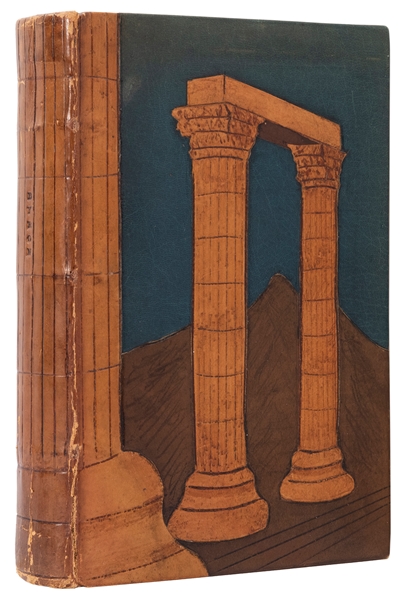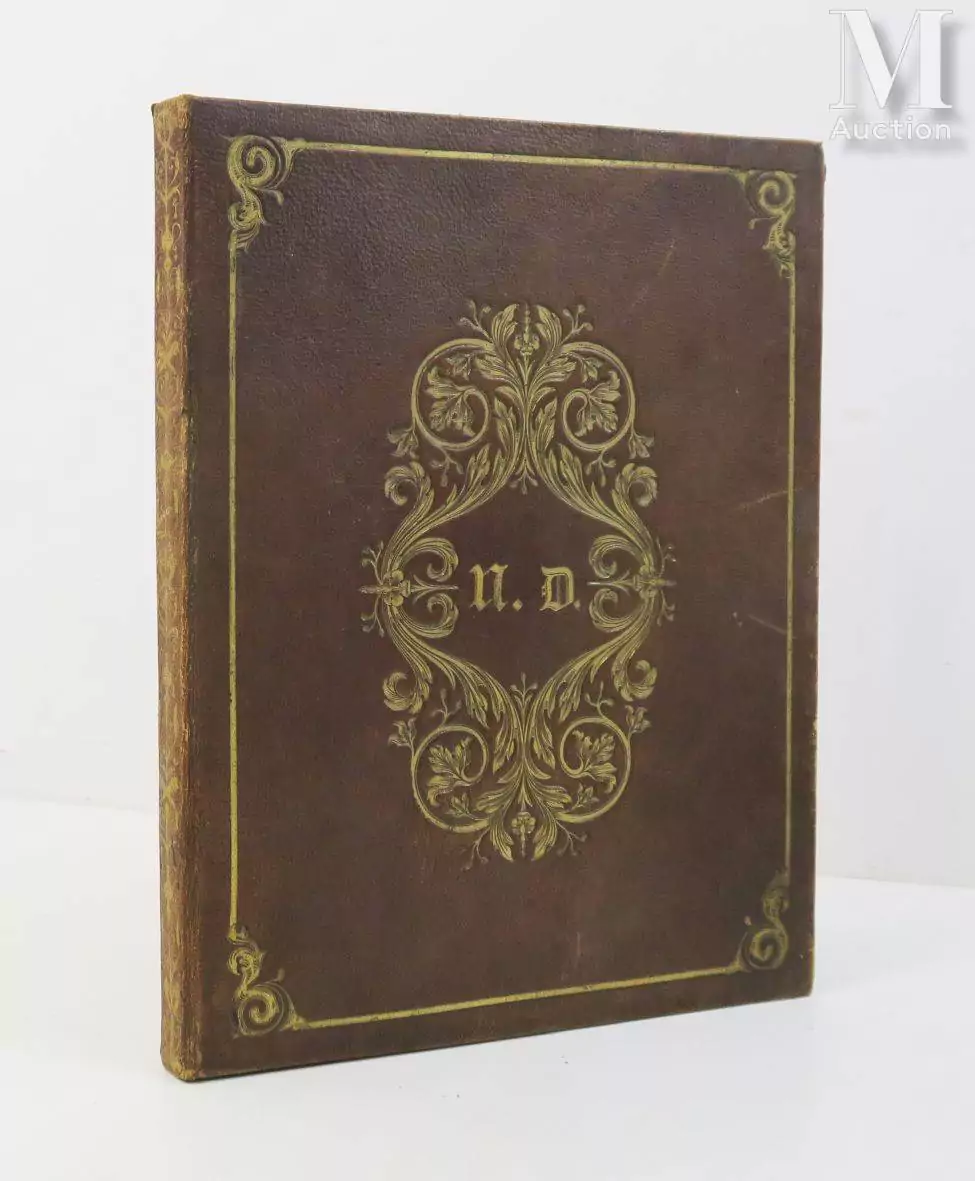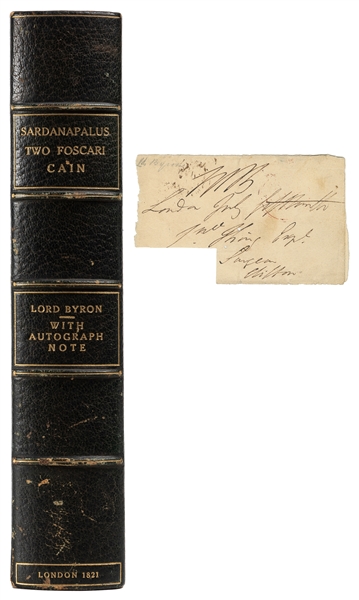BYRON (GEORGE GORDON LORD)Autograph letter signed ("Brn"), to John Murray ("Dear Sir"), thanking him for sending the sheets of "...the "Intercepted etc." which is a greater kindness than things of more importance would be...", and asking him if he attends to the printing, going on to speak of "...the wrath of the Courier..." and the proposed motion in the house, stating "...depend upon it – they shall not quell me into apology or submission...", docketed "1814 Feby 13th" and "Jany 21/ Augustus de Stäel", manuscript note tipped onto third page "This was addressed to Mr Murray by Lord Byron at the time there was a threat to arraign him for the libel in the lines addressed to the Princess Charlotte, beginning "Weep, Daughter, of a Royal Line" and the injunction in the letter to Mr Murray has reference to that threat", integral address panel, 3 pages on a bifolium, remains of red wax seal, dust-staining, remains of guard where previously mounted, 8vo (185 x 117mm.), [n.p.], 13 February [1814]Footnotes'THEY SHALL NOT QUELL ME INTO APOLOGY OR SUBMISSION': BYRON EMBROILED IN A ROYAL SCANDAL – A NEWLY DISCOVERED UNPUBLISHED LETTER TO HIS PUBLISHER.
The note of explanation attached to Byron's letter refers to the furore in the press and the government stirred up by the re-publication of his Sympathetic Address to a Young Lady, penned two years earlier. He was responding at the time to a quatrain published in the Morning Chronicle on 6 March 1812, which commented on a recent incident at Carlton House. The incident in question took place at a dinner on 22 February 1812, at which the Prince Regent quarrelled with Lord Lauderdale over the unfavourable response from Lords Grey and Greville to his suggestion made to the Duke of York that there should be a united administration. It is said he abused them in such violent language that a teenage Princess Charlotte, upset by the abandonment of her father's Whig supporters in favour of the Tories, dropped her head and burst into tears, upon which the Prince ordered the ladies from the room. It was common knowledge that the Princess's childhood had been a difficult one, with her parents separated and on terms of mutual loathing (see lot 51).
Byron's anonymous lines appeared on 7 March 1812:
WEEP, daughter of a royal line,
A Sire's disgrace, a realm's decay;
Ah! Happy if each tear of thine
Could wash a Father's fault away!
Two years later, in February 1814, 'either out of mere bravado or in an access of political rancour', the incident was brought up once again when the lines were reprinted with The Corsair in the Morning Chronicle, this time under Byron's own name and dedicated to Thomas Moore to whom the verses had been previously wrongly attributed. The publication led to vitriolic attacks on Byron and his friends in The Courier: '...Few of our readers have forgotten the disgust which this address excited. The author of it, however, unwilling that it should sleep in the oblivion to which it had been consigned with the other trash of that day, has republished it...'. The following day they continued their attack '...Lord Byron... has discovered and promulgated to the world in eight lines of choice doggerel, that the realm of England is in decay, that her Sovereign is disgraced, and that the situation of the country is one which claims the tears of all good patriots...'. This continued in similar vein throughout the greater part of February and March. Whilst Byron spoke lightly of the assaults, it is evident they annoyed him. On the 11th he wrote at length to Lady Melbourne on the press frenzy '...lampoons of all description, some good, and all hearty, the Regent (as reported) wroth... the Morning Post in hysterics; and the Courier in convulsions of criticism and contention... Did you know anything like this? At a time when peace and war, the Emperors and Napoleons... are trembling in the balance, the Government can devote half their attention... day after day, to 8 lines, written two years ago...'. His journal entry for 18 February on his return from Nottinghamshire notes: '...On my return I find all the newspapers in hysterics, and town in uproar... They are daily at it still;- some of the abuse good, all of it hearty. They talk of a motion in our House upon it – be it so...'.
This unpublished letter sits between correspondence from Byron to his publisher John Murray dated 12 February 1814 (Rowland E. Prothero, The Works of Lord Byron: Letters and Journals, 1899, Vol. 3, p.35, no.406), and another of the 14 February (Prothero, p.35, no.407) in which he refers to our letter sent on the 13th ('...Before I left town yesterday, I wrote you a note, which I presume you received...'). On the 12th he requested Murray send Lady Holland a volume of the Intercepted Letters (a reference to Letters and Dispatches of the Generals, Ministers etc., at Paris, to the Emperor Napoleon, at Dresden; Intercepted by the Advanced Troops of the Allies in the North of Germany) which, according to our letter, he had received by the next day, and complains of Murray's suppression of the verses whilst he was away. His note of the 14th continues the conversation begun in our letter: '...I can have no objection to your stating, as distinctly and publicly as you please, your unwillingness to publish them, and my own obstinacy upon the subject...'. It is not known how the letter reached the collection, but it could have been either a gift from Mary Berry or from a friend who knew of Lady Lewis' passion for collecting.
Provenance: Lady Maria Theresa Lewis (née Villiers) (1803-1865); her son Sir Thomas Villiers Lister (1832-1902); thence by descent.
Lady Lewis' collection was initially formed through the amalgamation of two significant collections of letters: royal and political correspondence from that of her mother the Hon. Theresa Villiers (1775-1856), and that of her close friend, the writer Mary Berry (1763–1852). Mary Berry's bequest included correspondence from Horace Walpole most notably his correspondence with Thomas Chatterton and David Hume, hitherto thought lost, and three poems dedicated to her. To this inheritance Lady Lewis subsequently added her own correspondence and collection of autographs gathered through her wide circle of social, political and literary connections entertained at her home, Kent House, St James's. Not seen outside the family until now, the collection is a remarkable survival and tells the story of a family at the heart of English society. An intricate web of connections and alliances is revealed, bringing together the worlds of royalty and politics, the arts and literature. It is also a story of influential women both as collectors and as correspondents: Theresa Villiers as keeper of royal secrets, Mary Berry and her circle of intellectuals, and, importantly, Lady Lewis as collector and salonnière bringing them all together in one extraordinary collection.
BYRON (GEORGE GORDON LORD)Autograph letter signed ("Brn"), to John Murray ("Dear Sir"), thanking him for sending the sheets of "...the "Intercepted etc." which is a greater kindness than things of more importance would be...", and asking him if he attends to the printing, going on to speak of "...the wrath of the Courier..." and the proposed motion in the house, stating "...depend upon it – they shall not quell me into apology or submission...", docketed "1814 Feby 13th" and "Jany 21/ Augustus de Stäel", manuscript note tipped onto third page "This was addressed to Mr Murray by Lord Byron at the time there was a threat to arraign him for the libel in the lines addressed to the Princess Charlotte, beginning "Weep, Daughter, of a Royal Line" and the injunction in the letter to Mr Murray has reference to that threat", integral address panel, 3 pages on a bifolium, remains of red wax seal, dust-staining, remains of guard where previously mounted, 8vo (185 x 117mm.), [n.p.], 13 February [1814]Footnotes'THEY SHALL NOT QUELL ME INTO APOLOGY OR SUBMISSION': BYRON EMBROILED IN A ROYAL SCANDAL – A NEWLY DISCOVERED UNPUBLISHED LETTER TO HIS PUBLISHER.
The note of explanation attached to Byron's letter refers to the furore in the press and the government stirred up by the re-publication of his Sympathetic Address to a Young Lady, penned two years earlier. He was responding at the time to a quatrain published in the Morning Chronicle on 6 March 1812, which commented on a recent incident at Carlton House. The incident in question took place at a dinner on 22 February 1812, at which the Prince Regent quarrelled with Lord Lauderdale over the unfavourable response from Lords Grey and Greville to his suggestion made to the Duke of York that there should be a united administration. It is said he abused them in such violent language that a teenage Princess Charlotte, upset by the abandonment of her father's Whig supporters in favour of the Tories, dropped her head and burst into tears, upon which the Prince ordered the ladies from the room. It was common knowledge that the Princess's childhood had been a difficult one, with her parents separated and on terms of mutual loathing (see lot 51).
Byron's anonymous lines appeared on 7 March 1812:
WEEP, daughter of a royal line,
A Sire's disgrace, a realm's decay;
Ah! Happy if each tear of thine
Could wash a Father's fault away!
Two years later, in February 1814, 'either out of mere bravado or in an access of political rancour', the incident was brought up once again when the lines were reprinted with The Corsair in the Morning Chronicle, this time under Byron's own name and dedicated to Thomas Moore to whom the verses had been previously wrongly attributed. The publication led to vitriolic attacks on Byron and his friends in The Courier: '...Few of our readers have forgotten the disgust which this address excited. The author of it, however, unwilling that it should sleep in the oblivion to which it had been consigned with the other trash of that day, has republished it...'. The following day they continued their attack '...Lord Byron... has discovered and promulgated to the world in eight lines of choice doggerel, that the realm of England is in decay, that her Sovereign is disgraced, and that the situation of the country is one which claims the tears of all good patriots...'. This continued in similar vein throughout the greater part of February and March. Whilst Byron spoke lightly of the assaults, it is evident they annoyed him. On the 11th he wrote at length to Lady Melbourne on the press frenzy '...lampoons of all description, some good, and all hearty, the Regent (as reported) wroth... the Morning Post in hysterics; and the Courier in convulsions of criticism and contention... Did you know anything like this? At a time when peace and war, the Emperors and Napoleons... are trembling in the balance, the Government can devote half their attention... day after day, to 8 lines, written two years ago...'. His journal entry for 18 February on his return from Nottinghamshire notes: '...On my return I find all the newspapers in hysterics, and town in uproar... They are daily at it still;- some of the abuse good, all of it hearty. They talk of a motion in our House upon it – be it so...'.
This unpublished letter sits between correspondence from Byron to his publisher John Murray dated 12 February 1814 (Rowland E. Prothero, The Works of Lord Byron: Letters and Journals, 1899, Vol. 3, p.35, no.406), and another of the 14 February (Prothero, p.35, no.407) in which he refers to our letter sent on the 13th ('...Before I left town yesterday, I wrote you a note, which I presume you received...'). On the 12th he requested Murray send Lady Holland a volume of the Intercepted Letters (a reference to Letters and Dispatches of the Generals, Ministers etc., at Paris, to the Emperor Napoleon, at Dresden; Intercepted by the Advanced Troops of the Allies in the North of Germany) which, according to our letter, he had received by the next day, and complains of Murray's suppression of the verses whilst he was away. His note of the 14th continues the conversation begun in our letter: '...I can have no objection to your stating, as distinctly and publicly as you please, your unwillingness to publish them, and my own obstinacy upon the subject...'. It is not known how the letter reached the collection, but it could have been either a gift from Mary Berry or from a friend who knew of Lady Lewis' passion for collecting.
Provenance: Lady Maria Theresa Lewis (née Villiers) (1803-1865); her son Sir Thomas Villiers Lister (1832-1902); thence by descent.
Lady Lewis' collection was initially formed through the amalgamation of two significant collections of letters: royal and political correspondence from that of her mother the Hon. Theresa Villiers (1775-1856), and that of her close friend, the writer Mary Berry (1763–1852). Mary Berry's bequest included correspondence from Horace Walpole most notably his correspondence with Thomas Chatterton and David Hume, hitherto thought lost, and three poems dedicated to her. To this inheritance Lady Lewis subsequently added her own correspondence and collection of autographs gathered through her wide circle of social, political and literary connections entertained at her home, Kent House, St James's. Not seen outside the family until now, the collection is a remarkable survival and tells the story of a family at the heart of English society. An intricate web of connections and alliances is revealed, bringing together the worlds of royalty and politics, the arts and literature. It is also a story of influential women both as collectors and as correspondents: Theresa Villiers as keeper of royal secrets, Mary Berry and her circle of intellectuals, and, importantly, Lady Lewis as collector and salonnière bringing them all together in one extraordinary collection.











Testen Sie LotSearch und seine Premium-Features 7 Tage - ohne Kosten!
Lassen Sie sich automatisch über neue Objekte in kommenden Auktionen benachrichtigen.
Suchauftrag anlegen